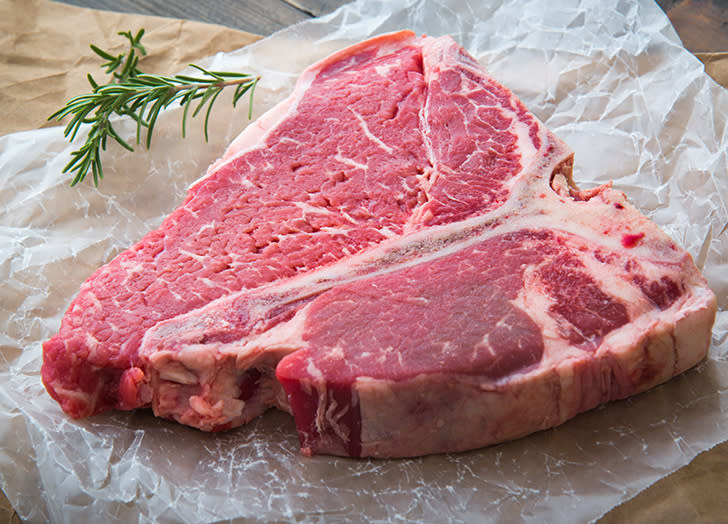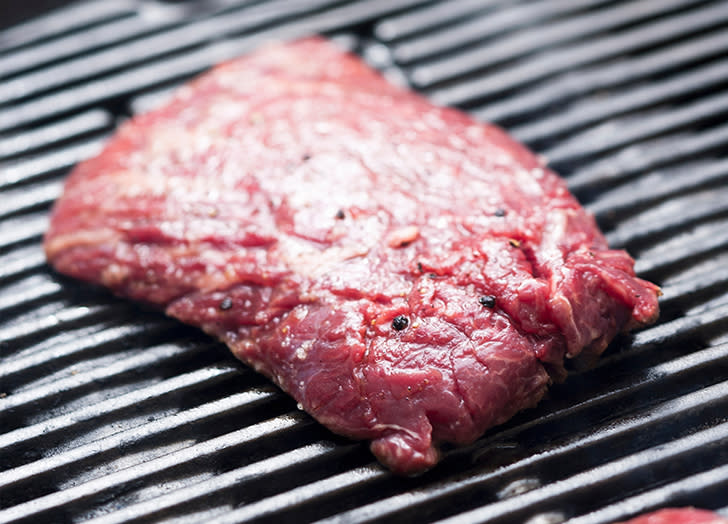15 Types of Steak All Home Cooks Should Know

We enter the butcher shop (or meat department) with the confidence of a five-star chef. Then we look at the myriad options and realize in a panic, I have no idea what I’m doing!!! Deciding to have steak for dinner is easy, but choosing the actual cut of meat (and then figuring out how to cook it) can be overwhelming. No worries: Here, 15 types of steak every home cook should know—from ribeye to rump and beyond—plus the best ways to prepare them.
RELATED: 16 Types of Soup You Should Know How to Make

1. Ribeye Steak
Ribeyes are sometimes labeled as Delmonico steaks, and they’re all about fat. Ribeyes have tons of marbling, and therefore a lot of flavor, so it makes sense that many people consider them one of the best-tasting types of steak.
How to cook it: If you buy a ribeye with lots of marbling, you won’t need more than salt and pepper to dress it up. Cook it over high heat on the grill or in a cast iron skillet to get a good sear, and don’t worry too much about accidentally overcooking it, since it has enough fat to remain juicy.
Try it: Ribeye Steak

2. Strip Steak
Also known as New York Strip (when it’s boneless), Kansas City Strip (when it’s bone-in) or Top Sirloin, strip steak comes from the short loin region of the cow. It’s a steakhouse favorite because it has a strong beefy flavor and decent marbling. It has a relatively tender texture but retains a bit of chew, and it’s pretty easy to cook.
How to cook it: You can pan-fry, grill or even sous-vide a strip steak. Treat it the same as a ribeye steak (salt and pepper, high heat), but know that since it has slightly less fat content, it’s better to err on the rarer side.
Try it: Strip Steak with Harissa Butter and Parsley

3. Tenderloin Steak
If you’ve had a filet mignon, you’ve had a type of tenderloin steak. Since a cow’s tenderloin muscle doesn’t get a ton of exercise, these little guys are extremely lean and—surprise, surprise—tender. They’re considered less flavorful than other cuts, but make up for it with their smooth, buttery texture.
How to cook it: Since tenderloin steaks are pretty devoid of fat, you definitely don’t want to dry them out. Start with a cast iron skillet over high heat, and a quick sear on each side will do.
Try it: Filet Mignon with Garlic Butter

4. Porterhouse Steak
This large cut of beef actually contains two types of steak in one: tenderloin and strip steak. It’s also always sold on the bone. While delicious, that makes it harder to cook, since you’re working with two different fat contents. (Psst: While used interchangeably, the porterhouse and T-Bone are technically different. The Porterhouse is thicker and cut from the back end of the short loin, so it contains more tenderloin meat in each steak.)
How to cook it: You can treat a porterhouse like a strip steak, cooking it over high, dry heat to medium-rare. To ensure the tenderloin and strip sections are done at the same time, position the tenderloin further from the heat source (and use a meat thermometer to really nail the doneness).
Try it: Pan-Seared Steak

5. Hanger Steak
Hanger steak—which comes from the plate, or upper belly, of the cow—has a ton of beefy flavor (some say it tastes mineral-y) and a loose texture that’s good for marinating. It’s extremely tender and is traditionally used in Mexican cuisine.
How to cook it: Hanger steak is best when marinated in an acid (like citrus or vinegar) and seared over high heat. Serve it between medium and medium-rare so it’s not too wet or too dry.
Try it: Simple Grilled Hanger Steak with Worcestershire, Garlic and Thyme

6. Skirt Steak
Have you ever had fajitas? If the answer is yes, then you’ve probably tasted a skirt steak. This long, thin, super fatty cut of beef comes from the plate section of the belly. Since it has a lot of connective tissue, it’s really tough, but if you cook it correctly, it can turn out tender. Skirt steak tastes rich and buttery thanks to all that fat.
How to cook it: The loose texture of skirt steak means it’s good for marinating, and you’ll want to cook it over very high heat (either pan-seared or on the grill) to get a good char on the outside without overcooking the center. Fair warning: Cut it against the grain or it will be chewy.
Try it: Marinated Skirt Steak with Chimichurri

7. Short Ribs
Did you know you could grill short ribs? Yep, this cut of beef is not just for braising. It’s marbled like a ribeye, with a ton of flavor and a thick, meaty texture (not to mention it’s way cheaper). You can buy short ribs cut thick or thin.
How to cook it: After seasoning with salt and pepper, grill short ribs over hot but not blazing heat, aiming for medium-rare doneness. Slice against the grain to avoid toughness. They’re delicious with a bright chimichurri sauce, in case you’re wondering.
Try it: Slow-Cooker Korean Short Rib Tacos

8. Flap Steak
Flap steak comes from the bottom of the sirloin, close to the flank. It’s sweet and mineral tasting, with a coarse, loose texture similar to skirt or flank steak. That loose, open grain means it’s good for marinating and holds seasoning in all those nooks and crannies.
How to cook it: Grill flap steak over high heat to medium and slice it thinly against the grain to keep it tender.
Try it: Steak Tacos with Cucumber Salsa

9. Flank Steak
Flank steak is a lot like skirt steak but with a few key differences. It’s usually thicker and wider with clean-cut edges, and it comes from the rear-end of the cow’s belly. It cooks up slightly more tender than skirt steak , but it has a similar mild flavor and takes well to marinating.
How to cook it: Whether pan-searing or grilling, cook flank steak over high temperatures to no more than medium doneness (or it will be chewy). Slice it think against the grain to maximize its tender texture.
Try it: Grilled Flank Steak with Lemon-Herb Sauce

10. Tri-Tip
This super flavorful cut of beef is cut from the tri-tip roast, found at the bottom sirloin of the cow. It rivals ribeye in marbling and flavor, but it’s much less expensive. It’s also very tender, as long as you don’t overcook it.
How to cook it: Tri-tips were destined for the grill. Use high heat and take care not to cook it past medium for the best texture and flavor. (If you want it more done than that, try marinating it for a few hours beforehand.)
Try it: Skillet Steak with Asparagus and Potatoes

11. Rump steak
“Rump” isn’t the most appealing name for a steak, but when cooked correctly, it’s a tasty and cheap cut of meat. (For what it’s worth, it’s also called round steak.) These steaks are lean and moderately tough, but are well-suited for marinating.
How to cook it: Rump steaks are best when marinated for at least four to five hours before cooking. Sear the steak in a cast iron skillet over high heat just to medium, then let it rest for 10 to 15 minutes before slicing against the grain.
Try it: Round Steak and Mushrooms

12. Top Sirloin Steak
There are a few types of sirloin cuts, but the top sirloin is the most tender. It’s a lean steak with a decent amount of beefy flavor considering its relatively inexpensive price tag.
How to cook it: Since sirloin steak is pretty lean, you’ll want to take care not to overcook it. Stay in the rare-to-medium range to avoid a dry steak. Cook it on the grill or pan-sear it, and dress it with a rub or herbs for extra flavor. (It’s also a good choice to turn into kebabs.)
Try it: Steak Skewers with Chimichurri Sauce

13. Tomahawk Steak
A tomahawk steak is nothing more than a ribeye steak with the bone still attached. It’s well-marbled with good flavor, and usually large enough to feed a few people (depending on how thick the bone is).
How to cook it: You can cook a tomahawk steak like you would a ribeye, over high heat on the grill or in a (large) skillet. If needed, you can always finish it in the oven after searing.
Try it: Juicy Tomahawk Steak

14. Denver
Denver steak is a bit of a newcomer—it’s only been around for about ten years—but it’s becoming increasingly available (and popular). It’s cut from a part of the cow’s shoulder called the eye of chuck, and while you’d think that would make it tough, it’s usually taken from the least-worked part of the muscle. That means it has a good amount of fat marbling and beefy flavor, but it’s still relatively tender.
How to cook it: The Denver steak does well with very high heat, so cook it on a very hot grill, broil it or pan-sear it. Cut across the grain for extra tenderness.
Try it: Grilled Shrimp and Steak Surf n’ Turf

15. Cube Steak
OK, technically, cube steaks are just top sirloin or top round steaks that have been flattened and pounded with a meat tenderizer. They have little fat and cook in almost no time at all, so it’s nearly impossible to achieve anything less than well-done.
How to cook it: Make cube steaks into chicken fried steak, which is breaded, fried and served with gravy.
Try it: Cube Steaks with Mushroom Gravy
A Few Final Tips for Cooking Steak:
While steak doneness is often based on personal preference, it can have a huge effect on the taste and texture of the final dish. As a general rule, the less fat and marbling a steak contains, the less you’ll want to cook it. (And we don’t usually go further than medium.)
Grilling isn’t the only way to cook steak, but it’s favored for imparting lots of char and smoky flavor. If you’re cooking a steak on the stovetop, use a heavy-bottom pan like cast iron, which will retain heat and give the steak a nice sear.
No matter what type of steak you’re cooking, let it come to room temperature before you cook it, season it generously with salt and always let it rest before slicing in.
You can check steak doneness with an instant-read thermometer: 125°F for rare, 135°F for medium-rare, 145°F for medium, 150°F for medium-well and 160°F for well-done. Remove the steak from the heat when it’s about 5 degrees lower than the desired doneness.
When in doubt, ask the butchers—they’re experts.

